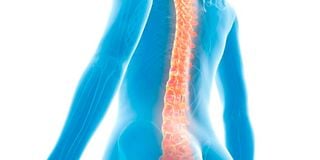Causes and treatment options for lower back pain in women

Degenerative disc disease is a condition that occurs when the discs in the spine begin to break down.
What you need to know:
- Lower back pain makes it hard for one to perform even simple tasks.
- However, there are home remedies for mild pain and treatments available for more severe cases.
- If you are struggling with lower back pain, talk to your doctor to find your best treatment option.
Did you know that over two-thirds of women will experience some form of lower back pain in their lifetime?
There are a number of causes of lower back pain in women including pregnancy and poor posture. Whatever the cause, there are treatment options available to alleviate the pain and get you back on your feet.
Poor posture
One often-overlooked cause of lower back pain is poor posture. Maintaining good posture requires muscles throughout the body, including those in the back and abdomen. When these muscles are not adequately supported, they can become fatigued, leading to pain and stiffness.
Additionally, poor posture can put undue strain on the spine, resulting in misalignment and further pain.
Solution: Exercises to strengthen the supporting muscles, as well as stretches to increase flexibility. By improving posture, it is possible to find relief from lower back pain.
Injuries and trauma
Injuries or trauma to the back is a common cause of lower back pain. These can range from minor sprains and strains to more severe conditions such as herniated discs or fractured vertebrae.
Many times, these injuries occur due to sudden movements or unexpected impacts. However, they can also develop over time due to repetitive motions.
If you have suffered an injury to your back, it is important to seek medical attention as soon as possible. Depending on the severity of the injury, you may need to rest and ice the area, wear a supportive brace, or undergo physical therapy. In some cases, surgery may be necessary.
Sedentary lifestyle
Sitting for extended periods can put a lot of strain on the lower back. This is because the position puts pressure on the spine and limited movement can lead to muscle stiffness.
Over time, this can lead to inflammation and pain. In addition, sitting for long periods can lead to weight gain, which puts additional strain on the lower back.
By making a few simple changes, you can ease lower back pain caused by a sedentary lifestyle. For example, taking regular breaks to move around and stretch can keep the muscles and joints mobile.
In addition, regular exercise can strengthen the muscles and improve flexibility. Finally, maintaining a healthy weight will help to reduce the amount of strain on the lower back.
Pregnancy
Lower back pain is a common complaint during pregnancy. There are a number of reasons why pregnancy can cause lower back pain. First, the extra weight of the growing baby puts strain on the muscles and ligaments in the back. As the baby grows, the centre of gravity shifts forward, putting even more stress on the back.
During the last few months of pregnancy, the hormone relaxin is released to prepare the body for childbirth. Unfortunately, this hormone relaxes the ligaments and joints, leading to instability and pain in the lower back.
Solution: Exercise, proper posture, wearing flat shoes, massage, and supportive clothing can help minimize discomfort. Additionally, your doctor may suggest over-the-counter or prescription medication to help manage pain.
Degenerative disc disease
Degenerative disc disease is a condition that occurs when the discs in the spine begin to break down. This can happen due to normal wear and tear.
When the discs degenerate, they lose their ability to cushion and support the spine. This can lead to pain, stiffness, and decreased mobility.
In some cases, surgery may be necessary to correct the problem. However, many nonsurgical treatment options can help relieve pain and improve function. These include physical therapy, exercises, and medications.
Preventive measures for lower back pain include:
- Maintaining a healthy weight
- Exercising regularly
- Wearing low-heeled shoes
- Using proper lifting techniques




